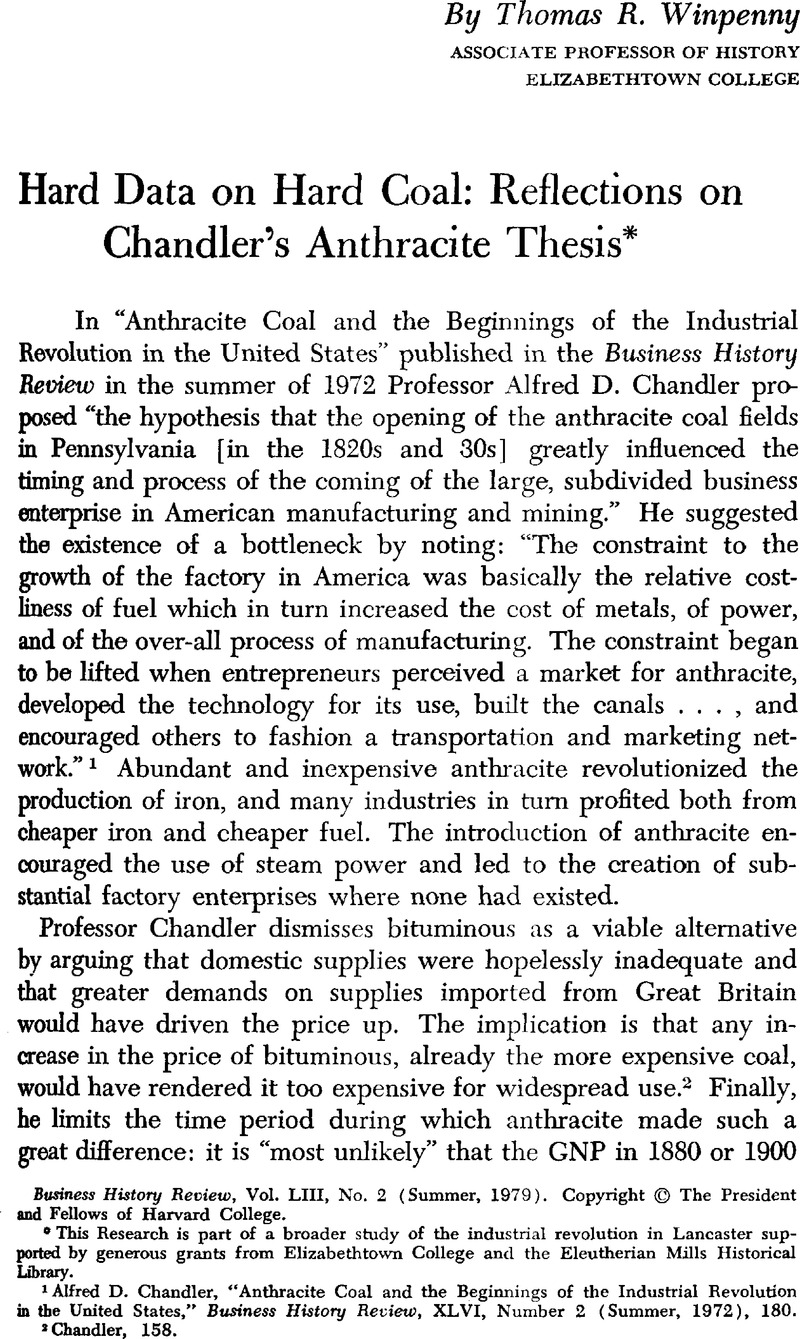Article contents
Hard Data on Hard Coal: Reflections on Chandler's Anthracite Thesis*
Published online by Cambridge University Press: 11 June 2012
Abstract

- Type
- Article Commentary
- Information
- Business History Review , Volume 53 , Issue 2: Featured: Early Commercial Aviaton , Summer 1979 , pp. 247 - 255
- Copyright
- Copyright © The President and Fellows of Harvard College 1979
References
1 Chandler, Alfred D., “Anthracite Coal and the Beginnings of the Industrial Revolution in the United States,” Business History Review, XLVI, Number 2 (Summer, 1972), 180.Google Scholar
2 Chandler, 158.
3 Chandler, 179.
4 Bishop, J. Leander, A History of American Manufactures, 1608–1860, Vol. I (Philadelphia, 1861), 461–462.Google Scholar
5 Klein, H. M. J., Lancaster County, Pennsylvania, Vol. I (New York, 1924), 282.Google Scholar
6 Livingood, James W., Philadelphia-Baltimore Trade Rivalry, 1780–1860 (Harrisburg, 1947), 153.Google Scholar
7 McLane, Louis, Documents Relative to the Manufactures in the United States, Vol. II (Washington, D.C., 1833), 252–526.Google Scholar
8 Niles' Register, November 30, 1833 (Baltimore, 1833), 217.
9 U.S. Bureau of the Census, Sixth Census of the United States: 1840. Manufactures. Manuscript.
10 U.S. Bureau of the Census, Seventh and Eighth Census of the United States: 1850 and 1860. Manufactures. Manuscript.
11 Data on “BTUs per ton,” later converted to “BTUs per dollar” based on Lancaster prices, were derived from U.S. Bureau of the Census, Historical Statistics of the United States (Washington, D.C., 1960), 336 and 355.Google Scholar
12 In 1850 there were nine steam engines with a combined rating of 657 horse power employed in Lancaster manufacturing. A decade later there were twenty-four with a combined rating of 1,020 horse power. In each instance users of steam power displayed a dear preference for burning anthracite. For a case study treating the influence of anthracite in the iron industry, see Stapleton, Darwin H., “The Diffusion of Anthracite Iron Technology: The Case of Lancaster County,” Pennsylvania History (April, 1978).Google Scholar
13 Chandler, 158.
14 Historical Statistics of the United States, 336 and 355.
15 Data on the Conestoga Steam Mill's contribution to value added and employment in manufacturing in both 1850 and 1860 were derived from the Seventh and Eighth Census. Manufactures. Manuscript.
16 Beyond the overpowering cotton mills, Henry Leman's rifle factory with sixty-two employees in 1860 was the town's next best example of the kind of large scale enterprise that Professor Chandler believes anthracite encouraged. The manufactures manuscript census provides excellent cost data for the rifle factory for 1850. It lists the following expenditures: $4,500 for 50 tons of bar iron, $500 for 2,500 gun “stalks,” $750 for 2,500 lbs. of brass, $225 for 50 tons of anthracite, and $9,792 for wages. Simple calculations demonstrate that fuel constituted only 1.43 per cent of the cost of material and labor. Had bituminous been substituted for anthracite, fuel would have constituted 1.67 per cent of material and labor costs. Thus the added burden would have been .24 per cent, or slightly less than one quarter of one per cent.
17 Both the Chandler paper and this paper assume that the preconditions for industrialization existed in the Northeast in the ante-bellum period.
18 The extraordinary role that James played as a promoter is considered in detail in a forthcoming article by T. R. Winpenny, “The Engineer as Promoter: Charles Tillinghast James and the Gospel of Steam Cotton Mills.”
19 There was also a great deal of popular support for tlie mills, as evidence by newspaper accounts of crowd behavior at public meetings where issues relating to the mills were considered. See the Lancaster Democrat, June–August, 1845.
20 When Lancaster entrepreneurs toured New England mills in 1845 they noticed the preponderance of females in Newburyport and recognized that a similar imbalance existed in Lancaster. Their report was published in the Lancaster Examiner and Herald, August 6, 1845.
- 3
- Cited by


